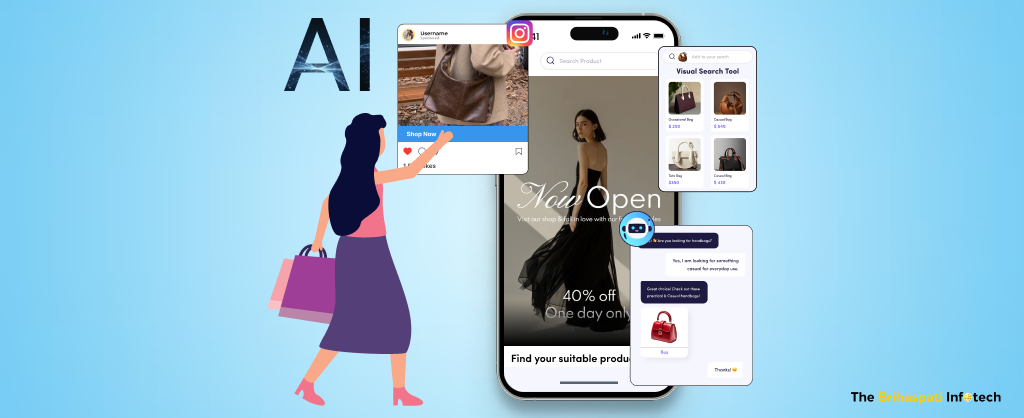
AI for eCommerce 2025: 3 AI Use Cases to Attract Gen Z Shoppers
Overview
Generative AI for eCommerce is no longer optional but essential for your retail success in 2025. With Gen Z emerging as the largest retail market, implementing AI tools is crucial to meet their dynamic expectations.
As per a 2025 retail report, 83% of businesses credit AI for driving revenue growth. Unfortunately, many retailers resist or lack the knowledge to implement generative AI for eCommerce success.
Our expert AI solutions for ecommerce have been at the forefront of implementing AI for Shopify, Magento, and WooCommerce stores. Whether you have a startup, small business, or large retail chains, you can count on our AI-driven eCommerce solutions.
This blog explores 3 AI use cases in eCommerce that can transform your retail store, including practical implementation steps. Let’s dive straight into action:
1. Visual Search Powered by Generative AI
AI-powered visual search tools enable shoppers to upload images to discover relevant products instead of typing queries. It is faster, more intuitive, and provides personalized shopping experiences. Combining it with AI-powered virtual try-on tools creates a personalized and interactive shopping experience.

How It Works:
AI visual search system analyzes the image to recognize patterns, colors, and shapes and then matches it with similar products from your store catalog. Thus, connecting shoppers with products they are looking for, instantly.
How to Implement Visual Search AI Tool for eCommerce Stores?
1. Choose a Visual Search Tool:
Choose any retail product discovery such as Syte* or Google Lens* API for generative AI eCommerce integration.
2. Integrate API:
For platforms like Shopify, WooCommerce, or Magento, either:
- Install an AI plugin (e.g., Syte Visual AI).
- Use APIs for a customized visual search solution. Our custom integration solutions can help streamline your AI and eCommerce projects.
3. Optimize Product Catalog:
Ensure all products are updated with comprehensive metadata, including:
- Attributes: Color, style, material, size, etc.
- High-resolution product images.
4. Set Up AI Search Widget:
Customize the tool’s interface to blend with your store’s branding and UX design.
5. Test and Monitor:
Conduct thorough testing to verify:
- The tool’s ability to match search images accurately.
- Performance consistency across different devices and browsers.
Brands Using AI for Visual Search: H&M, Amazon, and AKEA.
2. AI-Powered Shopping Assistants
Research shows that 51% of customers use AI chatbots for eCommerce shopping over human agents when it comes to fast service.
AI-powered shopping assistants are virtual agents that elevate the shopping experience to a scale never heard before. They aren’t limited to helping you pick the right product, but assist with complex interactions such as:
- Offering personal style advice.
- Tracking orders and managing returns.
- Recommending complementary products or bundles.
- Providing real-time pricing or stock updates.

How It Works:
AI-powered assistants use machine learning and natural language processing (NLP) to provide an elevated conversational commerce experience. They recommend products, handle FAQs, offer personalized discounts, confirm orders, help with returns, and so much more.
The magic behind these highly personalized recommendations often lies in predictive models that forecast user preferences, next-best actions, and purchase likelihood based on real-time behavior and historical data. For instance, our Gemini powered prediction software offers structured outputs and scalable personalization.
How to Implement AI Shopping Assistants for eCommerce Stores?
1. Choose a Chatbot Platform:
- Consider custom AI chatbots for your business or select any AI-driven shopping assistants, such as:
- Tidio*: For customer support and product recommendations.
- Dialogflow*: A robust solution for building virtual agents. Learn how to build a chatbot with Google Dialogflow here.
2. Integrate with Your Store:
- Link the assistant to your store’s backend for seamless functionality:
- Product Catalog: Use APIs to connect the assistant to real-time product data, like price, availability, and descriptions.
- Order Management Systems (OMS): Enable the assistant to provide order tracking updates and facilitate returns or exchanges.
- CRM Tools: Integrate with platforms like Salesforce for personalized experiences.
3. Train the AI Tool:
- Train the assistant using AI to:
- Analyze customer behavior, such as browsing history and shopping preferences.
- Provide tailored product recommendations and promotional offers.
- Deliver dynamic content based on location, demographics, or purchase history.
4. Deploy Across Channels:
- Ensure the assistant is accessible wherever your customers are:
- On-Site Deployment: Add live chat widgets to your website.
- Social Media Channels: Enable generative AI integration with Facebook Messenger, Instagram, etc.
- Messaging Platforms: Deploy AI shopping assistants for eCommerce on WhatsApp for direct support.
5. Test, Monitor, and Optimize:
- Perform rigorous testing to validate:
- The natural language understanding and relevance of responses.
- The ability to handle complex queries.
- Use analytics to track engagement rates, conversions, and FAQs resolved.
- Update the assistant’s training dataset to adapt to changing customer behaviors.
Brands using AI Shopping Assistants: Sephora’s “Virtual Artist”, H&M’s “virtual stylist”, and Amazon’s “Rufus”.
3. AI-Powered Shoppable Videos
Gen Z’s attention span is just 1.3 seconds, the shortest of any age group. It’s no surprise that 57% of them turn to short videos for product research.
Shoppable videos enable shoppers to buy products directly from videos. Powered by AI, these videos automate content creation, embed purchase links, and significantly shorten the buying journey. Through our artificial intelligence development services, we help businesses build and integrate intelligent shoppable video solutions that drive engagement and conversions.
Simply put, a shoppable video is an interactive video that seamlessly blends in with a product or service.

How It Works:
AI-powered shoppable videos use artificial intelligence to identify and tag products featured in a video automatically. Viewers can click on the tags to learn more about the products and order directly from the video.
How to Implement AI Shoppable Videos for eCommerce Stores?
1. Select an AI Video Tool:
- Tolstoy*: Ideal for creating interactive shoppable videos; perfect for Shopify stores.
- Sora AI*: Automate video generation for enterprises; great for Magento
- Elai.io*: Create highly engaging Avatars for your brand. An all-in-one video creation tool for all eCommerce platforms.
2. Install the Tool or AI Plugin:
- For Shopify: Visit the Shopify App Store and install the preferred AI video tool plugin.
- For WooCommerce: Download and configure the tool’s plugin from the WordPress plugin directory.
- For Magento: Use extensions available through Adobe’s Marketplace or the tool’s official website.
3. API Integration
- Obtain the API key and integrate the tool with your store backend.
- Set up the tool as documented.
4. Configure the Tool
- Use the tool’s dashboard to align video templates with your brand’s look and feel.
- Configure options like product links, purchase buttons, and branding elements.
- Define where videos will appear (e.g., product pages or homepage).
5. Embed Video Widgets
- Generate embed codes for shoppable videos using the tool’s interface.
- Add these codes to your store’s HTML or via your eCommerce platform’s page editor.
- Place videos on high-conversion pages like product details, landing pages, and checkout upsell sections.
6. Test AI eCommerce Integration
- Test to ensure the tool functions as expected, including proper linking to product pages and checkout.
- Verify responsiveness across devices (desktop, mobile, and tablet).
7. Launch and Monitor Performance
- Launch the tool and monitor video engagement using the tool’s analytics dashboard.
- Use insights to refine placement, design, and content for optimal conversions.
Brands Using AI-Driven Shoppable Videos: Puma, L’Oréal, and ASOS.
Bonus Use Case: Agentic AI for eCommerce Stores
What Is Agentic AI?
Agentic AI is an advanced AI system that takes actions, adapts in real-time, and solves complex problems without human oversight. The advanced AI technology offers a suite of tools and services to help AI agents work seamlessly across platforms.
What Agentic AI for eCommerce Means to Retailers?
Agentic AI for eCommerce marks a huge leap in retail store automation, personalization, and operational efficiency. Here’s what it means:

How It Works:
Agentic AI operates through autonomous “agents” designed to tackle specific tasks using machine learning, NLP, and predictive analytics. These agents gather, reason, act, learn, and collaborate to make real-time decisions and optimize workflows. Leveraging advanced technologies and a collaborative, open-source approach, agentic AI will transform the way various industries interact with technology.
Brands Using Agentic AI: Walmart, Amazon, and eBay.
Connect with our AI experts for eCommerce to implement Agentic AI solutions that enhance personalization, automate operations, and drive smarter retail experiences.
Frequently Asked Questions
AI chatbots for eCommerce and AI shopping assistants may sound the same, but they are not. AI shopping assistants are next-level AI chatbots.
Here are some key differences between the two:
1. Purpose: Chatbots resolve simple queries with pre-written responses, while AI shopping assistants handle complex, personalized tasks.
2. Interaction Style: Chatbots recognize text; AI shopping assistants rely on NLP for conversational interactions.
3. Personalization: Chatbots provide answers based on structured data; AI shopping assistants offer personalized recommendations based on user behavior.
4. Use Case: Chatbots are good at tracking orders and answering common questions; AI shopping assistants drive conversions by assisting in product discovery and final purchase.
5. Technology: Chatbots work on rule-based logic; AI shopping assistants use machine learning and real-time analytics.
Looking to implement intelligent AI shopping assistants or advanced chatbots? Hire AI developers to build scalable, conversion-driven AI solutions tailored to your eCommerce business.
The success of generative AI integration depends on your eCommerce platform. Most AI tools for eCommerce come with plugins or APIs for Shopify, WooCommerce, or Magento, making the process relatively straightforward.
Our eCommerce developers can assist in seamless integration and customization. Contact Us
For businesses that are ready to use AI for ecommerce, it’s important to create a plan of action. Here are the key steps:
1. Determine your Business Goals: Define specific objectives like increasing conversions and reducing product returns.
2. Choose AI Tools for eCommerce: Research and select tools that align with your business needs.
3. Collect and Analyze Data: Use AI-powered analytics to collect insights on customer behavior, shopping preferences, and trends.
4. Integrate AI Solutions: Connect AI tools to your platform (Shopify, WooCommerce, Magento) using APIs or plugins.
5. Train and Test: Train AI systems with accurate data and run pilot tests to evaluate performance.
6. Monitor and Optimize: Regularly analyze and improve AI’s performance.
Start your journey to retail success with us as your eCommerce partner.
4. Do eCommerce AI solutions require ongoing maintenance and updates?
Yes, AI tools for eCommerce often require regular updates to stay aligned with technology advancements and changing customer expectations. Maintenance includes monitoring data accuracy, training the system, and addressing bugs or performance issues.
Implementing AI for eCommerce stores comes with many challenges. Here are some common challenges:
1. Generative AI Integration Complexity: Integrating AI solutions with platforms like Shopify may require customization.
2. Data Quality: Inconsistent or poor-quality data can lead to unreliable results and impact AI’s effectiveness for training.
3. Customer Privacy Concerns: Collecting and using customer data for AI raises privacy and compliance issues, especially with strict regulations like GDPR and CCPA.
4. Ongoing Maintenance: AI solutions need regular updates, retraining, and optimization.
High Initial Investment: Many high-performing AI tools for eCommerce require significant upfront costs.
We can help eCommerce stores overcome obstacles in integrating AI solutions for retail success. Contact Us
*Disclaimer
We would like to clarify that we have no affiliation, association, or endorsement with AI Tools, or its affiliated companies mentioned in the blog. Any references made to Syte, Google Lens, Tidio, Dialogflow, Tolstoy, Sora AI, Elai.io, its products, services, or trademarks are solely for informational purposes and do not imply any endorsement or partnership.
Ready to Start or Scale with AI in 2025?
Generative AI for eCommerce has become an incredible power to reckon with. With GenZ demanding fast and convenient services, retailers must embrace AI-driven solutions to drive sales conversions. Implement AI visual search, virtual shopping assistants, shoppable videos, and many such tools to enhance CX and business sales.
To see how AI chatbots simplify everyday tasks, our Chatbot Business Automation Guide walks through practical examples and use cases.
At The Brihaspati Infotech, we offer end-to-end support for implementing AI tools and solutions for your eCommerce store—whether it’s Shopify, Magento, or WooCommerce. Our team guides you through every step, from strategy and integration to deployment and optimization.
Contact Us today to explore tailored AI solutions for your store!
Stay Tuned for Latest Updates
Fill out the form to subscribe to our newsletter








